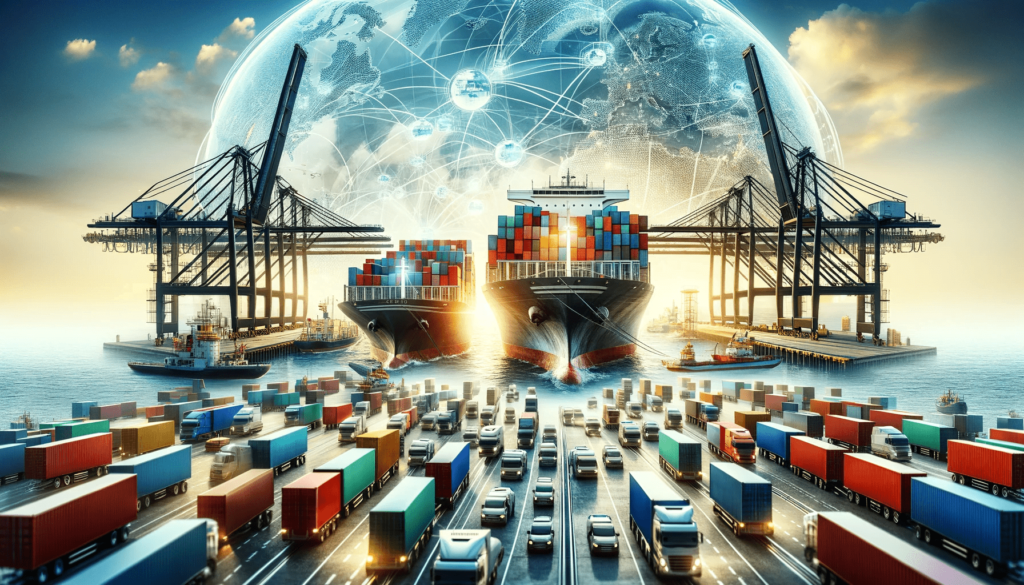Global shipping and logistics are fundamental to the seamless exchange of goods and services across continents. From managing intricate supply chains to ensuring timely deliveries, the industry serves as the backbone of international trade. This article explores the significance, challenges, and future trends of global shipping and logistics.
Why Global Shipping and Logistics Matter
Global shipping and logistics play a pivotal role in fostering economic growth and connecting markets worldwide:
- Trade Facilitation
By enabling the movement of goods across borders, the shipping industry strengthens global commerce and fosters economic interdependence. - Market Accessibility
Logistics ensures that even remote areas can access products and services, boosting local economies and improving living standards. - Economic Impact
The shipping industry contributes significantly to global GDP by creating jobs and supporting industries like manufacturing, retail, and agriculture. - Consumer Benefits
Through efficient logistics, consumers gain access to diverse products at competitive prices, regardless of geographic constraints.
Components of Global Shipping and Logistics
The industry encompasses a variety of interconnected systems that ensure the smooth flow of goods:
- Maritime Shipping: Handling 90% of international trade, container ships and tankers transport bulk goods such as machinery, oil, and food products.
- Air Freight: A faster but more expensive alternative for shipping high-value or time-sensitive goods.
- Land Transport: Trucks and trains bridge the gap between ports and inland destinations, facilitating last-mile delivery.
- Freight Forwarding: Experts in managing documentation, customs, and coordination among different transport modes.
- Warehousing: Plays a crucial role in inventory management and ensuring timely distribution to end-users.
Challenges in Global Shipping and Logistics
Despite its indispensable nature, the industry faces several challenges:
- Supply Chain Disruptions
Events like the COVID-19 pandemic highlighted the vulnerabilities of global supply chains, leading to significant delays and cost increases. - Environmental Impact
Shipping contributes to global greenhouse gas emissions, raising concerns about sustainability. - Geopolitical Tensions
Trade wars, sanctions, and regional conflicts can disrupt shipping routes and increase operational risks. - Technological Integration
Many companies struggle to adopt advanced technologies due to high costs or lack of expertise. - Infrastructure Limitations
Ports and logistics hubs in developing countries often face capacity issues, leading to bottlenecks and inefficiencies.
Emerging Trends in Global Shipping and Logistics
The industry is undergoing significant transformations to address modern challenges and capitalize on new opportunities:
1. Sustainability Initiatives
Shipping companies are adopting greener practices, such as using low-emission fuels, retrofitting vessels for energy efficiency, and leveraging renewable energy sources.
2. Digital Transformation
Technologies like blockchain, artificial intelligence, and the Internet of Things (IoT) are revolutionizing supply chain transparency and efficiency.
3. Autonomous Vehicles
Autonomous ships and drones promise to enhance operational efficiency, reduce labor costs, and minimize human error.
4. Diversification of Supply Chains
Companies are exploring multiple suppliers and alternative trade routes to mitigate risks associated with geopolitical instability.
5. Expansion of E-Commerce Logistics
The surge in online shopping has driven the demand for efficient and flexible logistics solutions, especially for last-mile deliveries.
The Role of Technology
Technology is a driving force in modernizing global shipping and logistics. Some key innovations include:
- Blockchain: Enhances security and transparency in documentation and transactions.
- Artificial Intelligence: Optimizes routes, forecasts demand, and automates repetitive tasks.
- IoT: Provides real-time tracking of shipments, improving accountability and customer satisfaction.
- Big Data Analytics: Enables better decision-making by analyzing patterns and trends in logistics operations.
Sustainability in Shipping and Logistics
Environmental concerns are reshaping the industry, pushing companies toward sustainable practices:
- Green Fuels: Adoption of alternative fuels like biofuels and LNG to reduce emissions.
- Energy-Efficient Vessels: New ship designs and retrofitting older fleets to meet environmental standards.
- Carbon Offset Programs: Many logistics providers are investing in renewable energy projects to offset their carbon footprints.
Future Outlook
As the global economy grows increasingly interconnected, the demand for efficient shipping and logistics will continue to rise. Innovations in technology and a greater focus on sustainability are poised to shape the industry’s future. Companies that adapt to these changes will not only improve their competitiveness but also contribute to a more resilient and sustainable global trade network.
Conclusion
Global shipping and logistics remain the cornerstone of international trade, ensuring that goods and services reach markets worldwide. While the industry faces challenges like supply chain disruptions and environmental concerns, emerging trends and technological advancements offer promising solutions.
By embracing innovation and prioritizing sustainability, the global shipping and logistics sector is well-positioned to drive economic growth and facilitate global connectivity for years to come.


